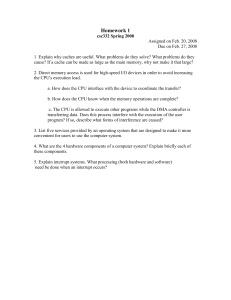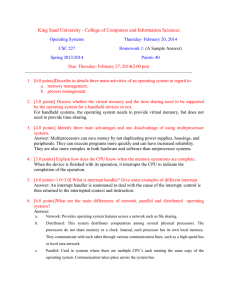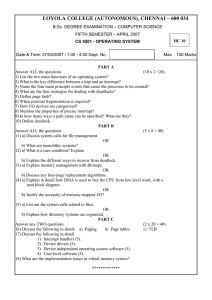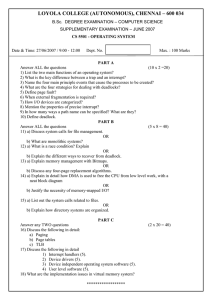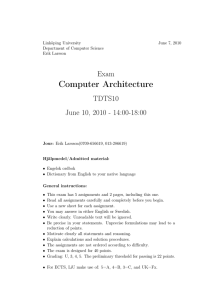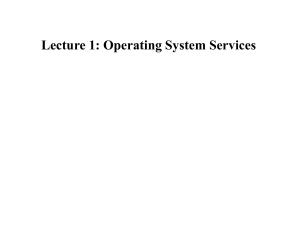Process concept
advertisement
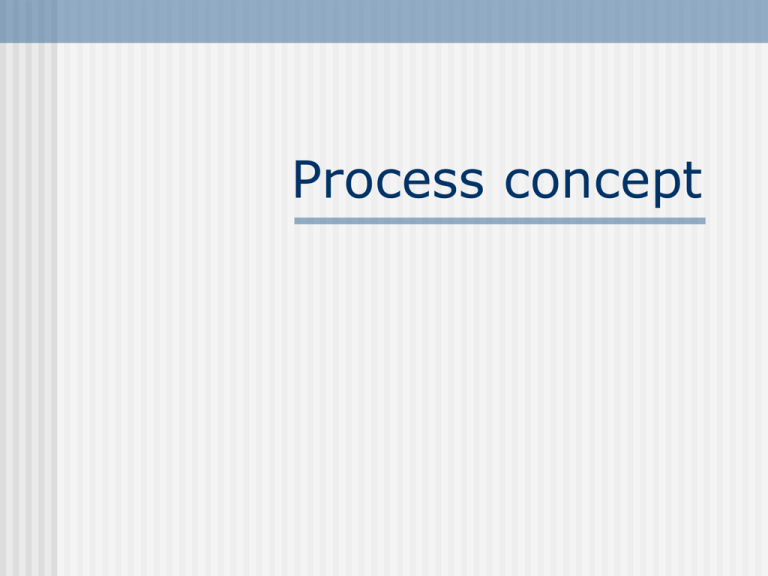
Process concept
Concept of Multiprogramming
When there is a single program running in the
CPU, it leads to the degradation of the CPU
utilization.
Example: When a running program initiates an
I/O operation, the CPU remain idle until the I/O
operation is completed.
Solution to this problem is provided by
Multiprogramming.
Multiprogramming Continued..
Definition:
A mode of operation that provides for
the interleaved execution of two or
more programs by a single processor.
Multiprogramming Continued..
Improving CPU utilization
By allowing several programs to reside in main
memory at the “same time” the CPU might be
shared,
such that when one program initiates an I/O
operation,
another program can be assigned to the CPU,
thus the improvement of the CPU utilization.
Multiprogramming Continued..
Implementation
The concept of process need to be
introduced in order to understand
multiprogramming and the concurrent
execution of sequential processes in a
computer system.
What is a process?
Process
Definition:
A program in execution
An asynchronous activity
The “locus of control” of a procedure in
execution
It is manifested by the existence of a
process control block (PCB) in the operating
system.
Process States
A state of a process describes the activity that
the process is doing at a certain moment in
time.
New
: A newly created process, not in the
ready queue.
Ready
: It can use the CPU , if available.
Running : If it is currently in the CPU.
Waiting : Waiting for some event ex: I/O
Abend
: Stops executing due to an error.
End
: Finished executing properly.
Suspended: Stops temporarily while the OS
uses the CPU
States of processes
SUSPENDED
END
NEW
READY
RUNNING
WAITING
ABEND
Causes of state change
When a process executes, it changes states and
interrupts cause process to change states.
Current State
New state
Interrupt
Running
End
EOP
( End of Program)
Running
(Abnormal end)
Running
(Start I/O)
ABEND
Trap
Blocked
for I/O
System Call
(SIO)
Depiction of state change
EOP
END
TRAP
ABEND
RUNNING
SIO
BLOCKED
Process Continued…
The activity of a process is controlled by a data
structure called Process Control Block(PCB).
A PCB is created every time a program is
loaded to be executed.
So, a process is defined by PCB-Program
couple.
Structure of PCB
PCB contains information about processes, for instance:
the current state of a process
Unique identification of process
Process priority
Contents of some CPU registers
Instruction Pointer (IP), also known as PC
Base and limit registers
Time limits and I/O status information
Structure of PCB Contd…
PROGRAM
S
T
A
C
K
Pointer to next PCB
Process name or ID
Base code
Limit….
Code
IP or PC
Stack Pointer
Registers
State
MODE
Interrupt Flags
.….
…..
Thread
Control
Block (TCB)
Process Continued…
A thread is known as “the unit of execution” of
a process and it is represented by the Thread
Control Block (TCB).
The TCB consists of four fields: PC, stack
pointer, the contents of some registers, and
the state.
Process Continued…
We can now observe how each stage of a
process takes place by the aid of a state
diagrams.
Process creation :
An OS can create one or more processes, via a
create-process system call.
During the course of execution an user process
may create new processes or threads as well.
In this case, the creating process (thread) is
called the parent and the created (new)
process (thread) is named the child.
Process Creation
New
Create
Ready
The process is created and then inserted at the
back of the ready queue, it moves to the head of
the queue according to a scheduling policy.
Process Creation Contd…
Program
Load
PCB
OS
code
Create
stack
Process Creation (closer view) Cont…
Create
OS
stack
PCB
heap
bss
Load
Program file
header
data
data
code
code
Process working space
Memory
symbol
table
Disk
Process working space (run-time environment)
stack
Dynamic link, return address,
Local variables, function
Parameters, …
heap
int z;
bss
int y = 7;
data
Dynamically allocated variables
Global and static variables
Constants / initialized data
code
Program text (write protected)
malloc(n);
x = 4;
Process working space
Process working space (run-time environment)
Process working space
sum
Local
bss: means “block started
by symbol” and has that
name for historical reasons.
stack
Local
Local
void sub(float total, int part ) {
int List[5];
float sum;
…
Local
}
Local
Local
Parameter
heap
Parameter
int z;
bss
Dynamic Link
int y = 7;
data
malloc(n);
x = 4;
code
Return Address
Thread working space (run-time environment)
Multithreading: Each thread is a unit of execution.
stack-T1
stack-T2
stack-main
Multithreaded processes
need a stack per thread.
All threads shared the same
address space.
Each thread has is own TCB.
heap
bss
data
code
Thread working space (run-time environment)
Multithreading: All threads share the CPU-PC and CPU-SP.
In this picture thread-T1 is using the CPU.
PCB
stack-T1
stack-T2
CPU
sp
stack-main
pc
regs
heap
bss
data
code
Process ID
SP
PC regs state TCB-T1
SP
PC regs state TCB-T2
SP
PC regs state TCB-main
.
.
.
Open files
Other resources
.
.
.
Memory snap shot of two processes in
Ready State
INTERRUPT HANDLER DISPATCHER RUNTIME LIBRARY
LOADER
RUNNING
READY
PCB1
1
st
a
c
k
PCB2
2
NULL
st
a
c
k
The PCB is stored in the OS memory area in a linked list.
Ready to Running
Dispatcher
RUNNING
READY
Timer Interrupt
When a process reaches the head of the queue and the CPU
is available, the process is dispatched which means that the
CPU is assigned to the process. This cause a transition
from the ready state to the running state.
When the time slice of the running process expires it goes
back to the ready state.
Ready to Running
INTERRUPT HANDLER DISPATCHER RUNTIME LIBRARY
LOADER
RUNNING
READY
PCB1
1
st
a
c
k
PCB2
2
st
a
c
k
INTERRUPT FLAGS
IP
OV MP
PI
Accumulator
TI I/O SVC
MASK
TO BE DEFINED LATER
Mode
CPU
Ready to Running
INTERRUPT HANDLER DISPATCHER RUNTIME LIBRARY
LOADER
RUNNING
READY
PCB1
1
st
a
c
k
PCB2
2
st
a
c
k
INTERRUPT FLAGS
IP
OV MP
PI
Accumulator
TI I/O SVC
PCB2
2
st
a
c
k
MASK
TO BE DEFINED LATER
Mode
CPU
Running to Ready
LOADER
INTERRUPT HANDLER DISPATCHER RUNTIME LIBRARY
RUNNING
READY
PCB2
PCB1
1
st
a
c
k
INTERRUPT FLAGS
IP
OV MP
PI
Accumulator
TI I/O SVC
2
st
a
c
k
MASK
TO BE DEFINED LATER
Mode
CPU
Running to Ready
INTERRUPT HANDLER DISPATCHER RUNTIME LIBRARY
LOADER
RUNNING
READY
PCB2
2
st
a
c
k
st
a
c
k
1
INTERRUPT FLAGS
IP
OV MP
PCB2
PCB1
PI
Accumulator
TI I/O SVC
2
PCB1
st
a
c
k
1
st
a
c
k
MASK
TO BE DEFINED LATER
Mode
CPU
Process Continued…
As the OS switches the allocation of CPU
among processes it uses the PCB to store the
CPU information or context, which represents
the state of the process.
In the previous example we have seen how
the OS performed a context switch between
processes P2(from Running to Ready) and
P1(from Ready to Running).
When a context switch occurs we need to save
the state of the running process in its PCB and
load the state of the new process in the CPU.
Case of Timer interrupt
P2
P1
Dispatch
RUNNING
READY
Timer Interrupt
After a timer interrupt, the OS move
P1 back to the ready state and the CPU
Is assigned to P2.
Context switching
EXECUTING
P1
OS
P2
WAITING
TIMER
Save state into PCB1
WAITING
WAITING
Reload state from PCB2
DISPATCH
WAITING
EXECUTING
Save state into PCB2
TIMER
WAITING
WAITING
Reload state from PCB1
DISPATCH
EXECUTING
WAITING
Case of I/O interrupt
RUNNING
READY
Start I/O (System call)
I/O Interrupt
WAITING
Case of I/O interrupt Contd..
LOADER
INTERRUPT HANDLER DISPATCHER RUNTIME LIBRARY
RUNNING
READY
PCB2
PCB1
PCB3
SIO
I/O
INTERRUPT FLAGS
IP
OV MP
Accumulator
PI
TI I/O SVC
MASK
TO BE DEFINED LATER
I/O DEVICE
Case of I/O interrupt Contd..
LOADER
INTERRUPT HANDLER DISPATCHER RUNTIME LIBRARY
RUNNING
READY
PCB1
PCB2
PCB2
PCB3
PCB3
I/O
INTERRUPT FLAGS
IP
OV MP
Accumulator
PI
TI I/O SVC
MASK
TO BE DEFINED LATER
I/O DEVICE
Case of I/O interrupt Contd..
LOADER
INTERRUPT HANDLER DISPATCHER RUNTIME LIBRARY
READY
OS
PCB1
RUNNING
PCB2
PCB3
I/O
SUSPEND
INTERRUPT FLAGS
IP
MASK
I/O DEVICE
OV MP
Accumulator
PI
TI I/O SVC
TO BE DEFINED LATER
Case of I/O interrupt Contd..
LOADER
INTERRUPT HANDLER DISPATCHER RUNTIME LIBRARY
READY
OS
PCB1
PCB3
RUNNING
PCB2
PCB3
I/O
SUSPEND
INTERRUPT FLAGS
IP
MASK
I/O DEVICE
OV MP
Accumulator
PI
TI I/O SVC
TO BE DEFINED LATER
Context switching
EXECUTING
P3
OS
P2
SIO
Save state into PCB3
Put P3 into the I/O queue
WAITING IN I/O
QUEUE
WAITING
EXECUTING
Reload state from PCB2
IN I/O STATE
WAITING
Suspend P2
READY STATE
DISPATCH
EXECUTING
I/O INTERRUPT
HANDLE I/O
SUSPENDED
Put P3 in Ready state
Resume P2
READY STATE
DISPATCH
EXECUTING
WAITING
Handling I/O:
Here the process waiting in the I/O
queue is moved back to the ready state after the
I/O request is completed.
End of Process
END
EOP
RUNNING
TRAP
ABEND
PCB
prog
stack
TRAP
1.
ABORT PROGRAM
2.
ERROR MESSAGE
3.
FREE RESOURSES
4.
DELETE PCB
OS
EOP
1.
PROGRAM RUNS
SUCCESSFULLY
2.
FREE RESOURSES
3.
DELETE PCB
